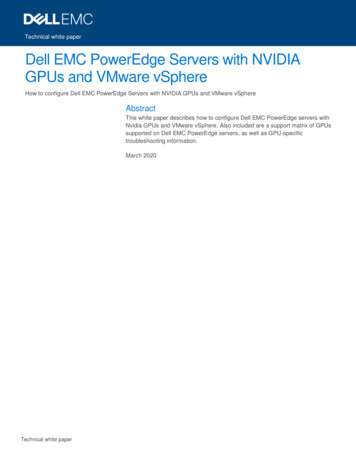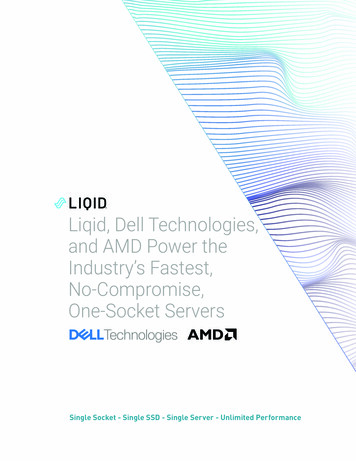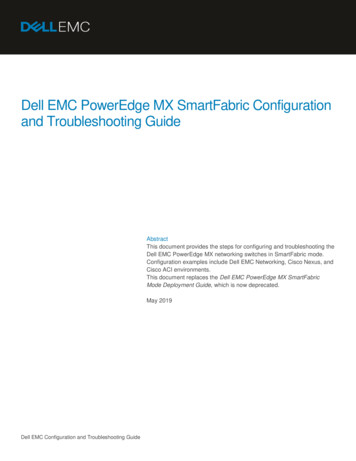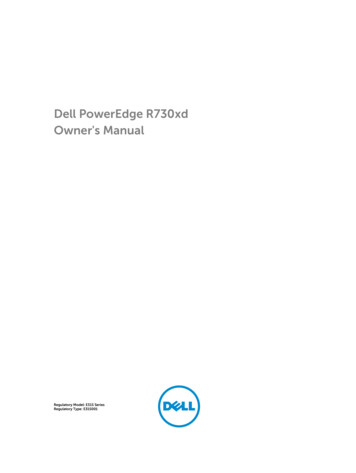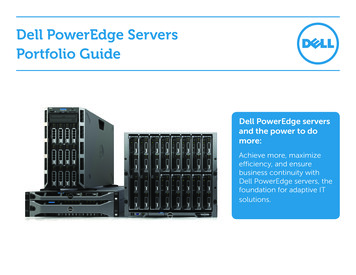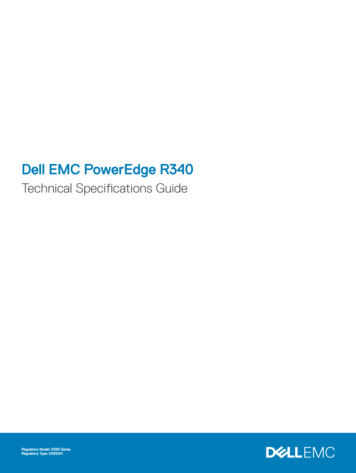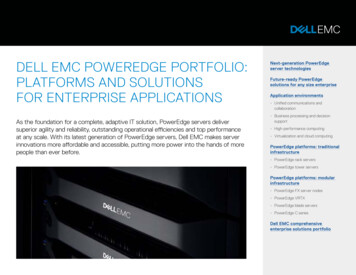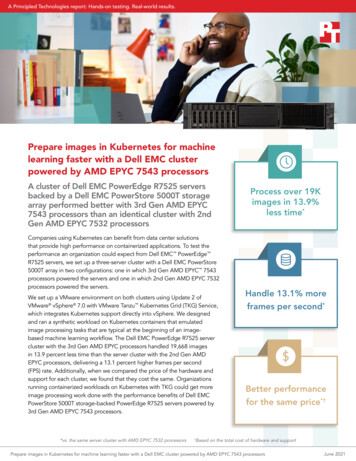
Transcription
A Principled Technologies report: Hands-on testing. Real-world results.Prepare images in Kubernetes for machinelearning faster with a Dell EMC clusterpowered by AMD EPYC 7543 processorsA cluster of Dell EMC PowerEdge R7525 serversbacked by a Dell EMC PowerStore 5000T storagearray performed better with 3rd Gen AMD EPYC7543 processors than an identical cluster with 2ndGen AMD EPYC 7532 processorsCompanies using Kubernetes can benefit from data center solutionsthat provide high performance on containerized applications. To test theperformance an organization could expect from Dell EMC PowerEdge R7525 servers, we set up a three-server cluster with a Dell EMC PowerStore5000T array in two configurations: one in which 3rd Gen AMD EPYC 7543processors powered the servers and one in which 2nd Gen AMD EPYC 7532processors powered the servers.We set up a VMware environment on both clusters using Update 2 ofVMware vSphere 7.0 with VMware Tanzu Kubernetes Grid (TKG) Service,which integrates Kubernetes support directly into vSphere. We designedand ran a synthetic workload on Kubernetes containers that emulatedimage processing tasks that are typical at the beginning of an imagebased machine learning workflow. The Dell EMC PowerEdge R7525 servercluster with the 3rd Gen AMD EPYC processors handled 19,668 imagesin 13.9 percent less time than the server cluster with the 2nd Gen AMDEPYC processors, delivering a 13.1 percent higher frames per second(FPS) rate. Additionally, when we compared the price of the hardware andsupport for each cluster, we found that they cost the same. Organizationsrunning containerized workloads on Kubernetes with TKG could get moreimage processing work done with the performance benefits of Dell EMCPowerStore 5000T storage-backed PowerEdge R7525 servers powered by3rd Gen AMD EPYC 7543 processors.*vs. the same server cluster with AMD EPYC 7532 processorsProcess over 19Kimages in 13.9%less time*Handle 13.1% moreframes per second*Better performancefor the same price*†Based on the total cost of hardware and support†Prepare images in Kubernetes for machine learning faster with a Dell EMC cluster powered by AMD EPYC 7543 processorsJune 2021
How we approached testingIn our data center, we compared the following clusters: A three-node cluster with Dell EMC PowerEdge R7525 servers, 3rd Gen AMD EPYC 7543 processors, anda Dell EMC PowerStore 5000T storage array. As of April 26, 2021, the price for hardware plus Basic NextBusiness Day support (36 months) for one server with 3rd Gen processors was 35,718.01, or 107,154.03 fora three-server cluster.1 The price of the Dell EMC PowerStore 5000T with ProSupport and Next Business DayOnsite Service (36 months) was 425,865.93.2 Adding these prices together, we found that the total cost ofthis cluster configuration came to 958,885.89. A three-node cluster with Dell EMC PowerEdge R7525 servers, 2nd Gen AMD EPYC 7532 processors, anda Dell EMC PowerStore 5000T storage array. As of April 26, 2021, the price for hardware plus Basic NextBusiness Day support (36 months) for one server with 2nd Gen processors was 35,718.01, or 107,154.03 fora three-server cluster.3 The price of the Dell EMC PowerStore 5000T with ProSupport and Next Business DayOnsite Service (36 months) was 425,865.93.4 Adding these prices together, we found that the total cost ofthis cluster configuration came to 958,885.89.Aside from the processors we tested, we configured the server clusters identically, equipping each with two480GB 6Gbps SATA M.2 SSDs, 512 GB of PC4-3200 RAM, a dual-port 1Gb Ethernet adapter, and a dual-portFibre Channel adapter for storage connectivity. We configured and created a 2TB volume on the Dell EMCPowerStore 5000T storage system, and then mapped the volume to all PowerEdge R7525 servers as a shareddatastore for TKG deployment. The vSphere with TKG cluster in our testing had 44 guaranteed-large workernodes and a pod on each node with 3 CPU threads and 10 GB of memory reserved. For more details about ourconfigurations and testing methodologies, see the science behind the report.About AMD EPYC 7543 processorsThese 32-core processors use AMD Infinity Architecture and arepart of the AMD EPYC 7003 Series. The latest offering from AMD,3rd Gen EPYC processors offer increased I/O with up to 32MB L3cache per core, 7nm x86 hybrid die core, and new security featuressuch as Secure Encrypted Virtualization - Secure Nested Paging(SEV-SNP) and Encrypted State (SEV-ES).5 According to AMD, theEPYC 7543 model is well suited for workloads such as analytics,CAE/CFD/FEA, and media streaming.6Learn more at .Prepare images in Kubernetes for machine learning faster with a Dell EMC cluster powered by AMD EPYC 7543 processorsJune 2021 2
Less time to process imagesBefore organizations can use their image-based machine learning algorithms to analyze data, they must firstprepare the data. The workload we used mimicked simple image processing tasks that a company might runon Kubernetes with TKG during this preparation phase. With a solution that can sort and prepare images faster,organizations working in areas such as manufacturing, healthcare, and security could reach insights sooner. (Seepage 5 for more real-world benefits.) As Figure 1 shows, Dell EMC PowerEdge R7525 servers powered by 3rdGen AMD EPYC 7543 processors and backed by the Dell EMC PowerStore 5000T array took 36 minutes and 41seconds to process 19,668 images—13.9 percent less time than the same servers and storage array with 2ndGen AMD EPYC 7432 processors, which took 42 minutes and 37 seconds.Time(minutes:seconds, lower is better)36:4142:37Dell EMC PowerEdge R7525 server clusterwith 3rd Gen AMD EPYC 7543 processorsDell EMC PowerEdge R7525 server clusterwith 2nd Gen AMD EPYC 7532 processorsProcess over19K imagesin 13.9%less timeFigure 1: Time to process a set of 19,668 images from the synthetic benchmark we used (minutes:seconds).Lower is better. Source: Principled Technologies.About Dell EMC PowerEdge R7525 serversAccording to Dell Technologies, these servers offer the following specifications:7 Up to 128 high-performance 3rd Gen AMD EPYC cores in two sockets Support for 24 Gen4 NVMe direct connections 32 DDR4 RDIMM or LRDIMM memory module slots Up to eight PCIe Gen4 slots Automated server life cycle management OpenManage Integration for VMware vSphere, which delivers server life cycle support in VMwarevCenter environments with hardware monitoring and alerts, VMware ESXi deployment, andfirmware management8To learn more, visit e-r7525.Prepare images in Kubernetes for machine learning faster with a Dell EMC cluster powered by AMD EPYC 7543 processorsJune 2021 3
About the Dell EMC PowerStore 5000TDuring testing, we backed each cluster configuration with a Dell EMC PowerStore 5000T storage array.According to Dell Technologies, “PowerStore T models provide organizations with all the benefits of anenterprise unified storage platform for block, file and vVol data, while enabling flexible growth with theintelligent scale-up and scale-out capability of appliance clusters.” The 5000T model offers unified block, file,and VMware vSphere vVols support, 898.56 TB of raw capacity, and 25 NVMe drive slots.9Learn more at Because our workload was CPU-intensive, the configurations only minimally utilized the storage array, whichindicates that the Dell EMC PowerStore 5000T had the resources available to potentially run other workloads orsupport more clusters. For more information on how the workload impacted the storage array during testing, seethe science behind the report.A higher FPS processing rateFigure 2 illustrates the image processing rate each solution achieved in our testing. The cluster with 2nd GenAMD EPYC 7432 processors and the PowerStore 5000T storage array achieved a rate of 8,263 FPS. Meanwhile,the 3rd Gen AMD EPYC 7543 processor-powered Dell EMC PowerEdge 7525 cluster with the PowerStore 5000Tstorage array processed the images at a rate of 9,349 FPS—an improvement of 13.1 percent.Image processing rate(frames per second, higher is better)9,3498,263Dell EMC PowerEdge R7525 server clusterwith 3rd Gen AMD EPYC 7543 processorsHandle 13.1%more framesper secondDell EMC PowerEdge R7525 server clusterwith 2nd Gen AMD EPYC 7532 processorsFigure 2: The image processing rate for each solution in frames per second (FPS). Higher is better.Source: Principled Technologies.Prepare images in Kubernetes for machine learning faster with a Dell EMC cluster powered by AMD EPYC 7543 processorsJune 2021 4
About VMware vSphere with TanzuTo run our workload, we used Tanzu Kubernetes Grid. VMware states that TKG is a “CNCF-certified,enterprise-ready Kubernetes runtime that streamlines operations across a multi-cloud infrastructure”10 thatalso “provides a consistent, upstream-compatible implementation of Kubernetes, that is tested, signed, andsupported by VMware.”11 TKG is part of the VMware Tanzu portfolio, which enables organizations to “build,run and manage modern apps on any cloud—and continuously deliver value to your customers,” as well as to“simplify multi-cloud operations and free developers to move faster with easy access to the right resources,”according to VMware.12The VMware Tanzu portfolio includes products that could enhance a user’s TKG deployment,including the following: Tanzu Mission Control: From a single pane of glass, Tanzu users can provision and manage their TKGclusters, secure apps and clusters with policy-based security features, and provide self-service Kubernetesto developers13 Tanzu Service Mesh: Allows users to secure applications through network encryption and authorizationpolices as well as auto-scale and load balance applications14 Tanzu Observability: Offers health and performance monitoring of applications and cloud infrastructure andalerting for on-premises and cloud-based Kubernetes clusters and applications15For more information, visit https://tanzu.vmware.com/tanzu.Real-world benefits for retailFor stores that use computer vision to prevent shoplifting, keeptheir shelves properly stocked, or optimize their marketing,accomplishing tasks in less time during the machine learningworkflow could translate to achieving those goals faster. Duringthe image preprocessing phase, which prepares images formachine learning algorithms, your company could save time byrunning vSphere with TKG workloads on Dell EMC PowerEdgeR7525 servers with 3rd Gen AMD EPYC 7543 processors backedby a Dell EMC PowerStore 5000T storage array. We saw aboost in performance when a cluster of these servers processedimages in 13.9 percent less time—and at a 13.1 percenthigher FPS rate—compared to the same servers with 2nd GenAMD EPYC processors and the same storage array. With thisincreased performance, your store could get important insightsin less time, enabling you to deliver a safe and personalizedshopping experience to your customers.Prepare images in Kubernetes for machine learning faster with a Dell EMC cluster powered by AMD EPYC 7543 processorsJune 2021 5
About VMware vSphere 7.0 Update 2We used VMware vSphere 7.0 Update 2 for our test environment. According to VMware, this vSphere 7.0 updateincludes a CPU scheduler that is optimized for AMD EPYC processors, as it is “designed to take advantage of themultiple last-level caches (LLCs) per CPU socket offered by the AMD EPYC processors.” VMware also states thatvSphere 7.0 Update 2 with the CPU scheduler can achieve near-optimal performance on most applications andbenchmarks on AMD EPYC processors.16For more information, visit usionIn a vSphere 7.0 Update 2 environment with Tanzu Kubernetes Grid, we compared the image processingperformance of Kubernetes workloads on two cluster configurations of Dell EMC PowerEdge R7525 servers:one cluster with 3rd Gen AMD EPYC 7543 processors and the other cluster with 2nd Gen AMD EPYC 7532processors. We backed both clusters with a Dell EMC PowerStore 5000T storage array, which showed minimalutilization during testing. We found that the cluster with the 3rd Gen AMD EPYC processors handled 13.1percent more frames per second, processing 19,668 images in 13.9 percent less time than the cluster withthe 2nd Gen AMD EPYC processors. These results indicate that without paying an increased price for newerhardware, an organization using vSphere with TKG to run their Kubernetes workloads could get better imageprocessing performance by choosing Dell EMC PowerEdge R7525 servers powered by 3rd Gen AMD EPYC 7543processors. By backing the servers with a Dell EMC PowerStore 5000T, they could also get additional storagesupport to run other workloads.Prepare images in Kubernetes for machine learning faster with a Dell EMC cluster powered by AMD EPYC 7543 processorsJune 2021 6
1“PowerEdge R7525 Rack Server,” accessed April 26, 2021, oweredge-r7525/.2On January 26, 2021, we received a quote from a third party reseller for the Dell EMC PowerStore 5000T.3“PowerEdge R7525 Rack Server,” accessed April 26, 2021, oweredge-r7525/.4On January 26, 2021, we received a quote from a third party reseller for the Dell EMC PowerStore 5000T.5“AMD EPYC 7003 Series Processors,” accessed April 26, 2021, .6“AMD EPYC 7543,” accessed April 26, 2021, 7“OpenManage Integration for VMware vCenter,” accessed April 30, 2021, rEdge R7525,” accessed April 26, 2021, https://i.dell.com/sites/csdocuments/Product Docs/en/PowerEdgeR7525-Spec-Sheet.pdf.9“Dell EMC PowerStore Storage Family,” accessed April 26, ell-emc-powerstore-family-spec-sheet.pdf.10 “VMware Tanzu Kubernetes Grid,” accessed May 18, 2021, G-Solution-Overview.pdf.11 “VMware Tanzu Kubernetes Grid Documentation,” accessed April 26, 2021, -Grid/index.html.12 “VMware Tanzu,” accessed April 26, 2021, -Tanzu-Solution-Brief-0121.pdf.13 “Multi-cluster Kubernetes management across clouds,” accessed April 30, 2021, https://tanzu.vmware.com/mission-control.14 “Enterprise-class service mesh,” accessed April 30, 2021, https://tanzu.vmware.com/service-mesh.15 “Enterprise observability for multi-cloud environments,” accessed April 30, 2021, https://tanzu.vmware.com/observability.16 “Performance Optimizations in VMware vSphere 7.0 U2 CPU Scheduler for AMD EPYC Processors,” accessed May 17,2021, cpusched-amd-epyc.pdf.Read the science behind this report at http://facts.pt/oYvyygsPrincipledTechnologiesThis project was commissioned by Dell Technologies. Principled Facts matter.Technologies Facts matter. Principled Technologies is a registered trademark of Principled Technologies, Inc.All other product names are the trademarks of their respective owners.For additional information, review the science behind this report.Prepare images in Kubernetes for machine learning faster with a Dell EMC cluster powered by AMD EPYC 7543 processorsJune 2021 7
running vSphere with TKG workloads on Dell EMC PowerEdge R7525 servers with 3rd Gen AMD EPYC 7543 processors backed by a Dell EMC PowerStore 5000T storage array. We saw a boost in performance when a cluster of these servers processed images in 13.9 percent less time—and at a 13.1 percent higher FPS rate—compared to the same servers with 2nd Gen

